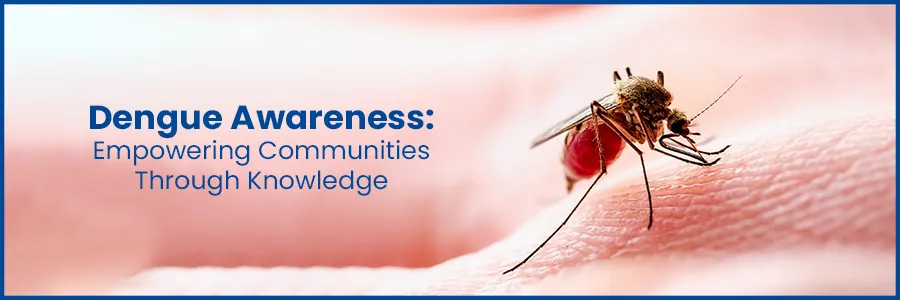Categories
- Cardiology 84
- Dermatology 45
- Endocrinology 33
- ENT 16
- Fertility 190
- Gastroenterology 78
- General-Medicine 81
- Gynecology 80
- Hematology 19
- Infectious-Diseases 33
- Neurology 52
- Oncology 34
- Ophthalmology 23
- Orthopedics 69
- Pediatrics 31
- Procedure 23
- Public-Health 144
- Pulmonology 59
- Radiology 8
- Urology 68
- Wellness 161
- Woman-and-child 77

Dengue Fever Awareness: What You Need to Know
Dengue fever affects millions of people worldwide each year and is a serious health risk. Urbanization, climate change, and increased human mobility are major contributors to the disease's rapid spread. The good news is that managing and preventing dengue is possible. Raising awareness within communities is crucial for controlling its spread.
This article explores key aspects of dengue awareness and how it empowers communities to take effective preventive measures.
Understanding Dengue: The Basics
The dengue virus, which is spread by Aedes mosquito bites, is what causes dengue fever. There are four different viral serotypes that are currently recognized. Only a certain degree of immunity exists against dengue, once a person has contracted one serotype, they are not protected against the others.
Hence, they may contract dengue more than once.
Secure your health with a second opinion. Make informed decisions and book your appointment today!
Get A Second OpinionSymptoms and Complications dengue fever:
The severity of dengue symptoms can vary, including
- High fever
- Severe headache
- Joint and muscle pain
- Rash
- Mild bleeding
Serious cases of dengue can develop into potentially fatal dengue shock syndrome or dengue hemorrhagic fever. For the disease to be managed and complications to be avoided, prompt medical intervention is essential.
Preventive Measures: Knowledge is Power
A key factor in limiting the spread of dengue is educating communities about how to prevent it. Among the crucial preventive actions are:
- Eliminating Mosquito Breeding Sites: Aedes mosquitoes procreate in still water. Communities may greatly minimize mosquito breeding sites by clearing out anything that can collect water, such as flowerpots, old tires, and open containers.
- Using Mosquito Nets and Repellents: In particular during periods of high mosquito activity, using mosquito nets while you sleep and dabbing exposed skin with repellents can help avoid mosquito bites.
- Wearing Protective Clothing:Socks, long sleeve shirts, and long pants can give another layer of protection against mosquito bites.
- Improving Sanitation: Mosquito breeding places can be reduced by disposing of waste properly and keeping the environment clean.
- Community Clean-Up Campaigns: Participating in neighbourhood-wide cleanup campaigns for public areas can significantly reduce mosquito breeding grounds.
Educational Initiatives: Spreading Awareness
Public awareness initiatives regarding dengue are crucial for informing people about the illness and how to prevent it. These campaigns may entail:
- Workshops and Seminars: Hosting talks and workshops to inform community members—particularly parents and caregivers—about the warning signs and symptoms of dengue, how to avoid contracting the disease, and how crucial it is to get medical help.
- School Programs: Dengue education should be incorporated into school curricula to make sure kids understand the illness and can assist in spreading awareness at home.
- Information Dissemination: Distributing instructional materials, posters, and brochures in the local tongues to effectively convey preventive measures.
Ready to take control of your health journey? Book your appointment now and start your path towards wellness today!
Book an AppointmentCollaboration and Action
The public, medical professionals, communities, and governmental organizations work together to raise awareness of dengue fever. Local health authorities and communities can collaborate to create action plans, put preventive measures into place, and successfully handle outbreaks.
Conclusion:
Educating communities about dengue is a potent weapon in the fight against the illness. Individuals may take control of their health and help make their neighbourhood and themselves safer by increasing awareness. We can greatly lessen the effects of dengue and create healthier communities by working together, spreading awareness, and taking action.
Frequently Asked Questions
Dengue fever is a viral illness transmitted by infected Aedes mosquitoes. It is characterized by symptoms like high fever, severe headache, joint and muscle pain, and rash.
Dengue is transmitted through the bite of Aedes mosquitoes, primarily Aedes aegypti and Aedes albopictus.
Common symptoms include fever, severe headache, pain behind the eyes, joint and muscle pain, rash, and mild bleeding.
Dengue symptoms can be similar to other viral fevers, but severe abdominal pain, persistent vomiting, and bleeding may indicate dengue.
No, dengue is not directly contagious. It spreads through mosquito bites.
Yes, in severe cases, dengue can lead to dengue hemorrhagic fever or dengue shock syndrome, which can be life-threatening if not treated promptly.
There's no specific antiviral treatment for dengue. Supportive care, fluid replacement, and rest are usually recommended.
Dengue can be diagnosed through blood tests, including NS1 antigen test and antibody tests.
Yes, a person can be infected with dengue multiple times, as there are four serotypes of the virus.
Yes, dengue can be prevented by eliminating mosquito breeding sites, using mosquito nets, wearing protective clothing, and using mosquito repellents.
Aedes mosquitoes serve as vectors, transmitting the dengue virus to humans through their bites.

Categories
- Cardiology 84
- Dermatology 45
- Endocrinology 33
- ENT 16
- Fertility 190
- Gastroenterology 78
- General-Medicine 81
- General 6
- Gynecology 80
- Hematology 19
- Infectious-Diseases 33
- Neurology 52
- Oncology 34
- Ophthalmology 23
- Orthopedics 69
- Pediatrics 31
- Procedure 23
- Public-Health 144
- Pulmonology 59
- Radiology 8
- Urology 68
- Wellness 161
- Woman-and-child 77